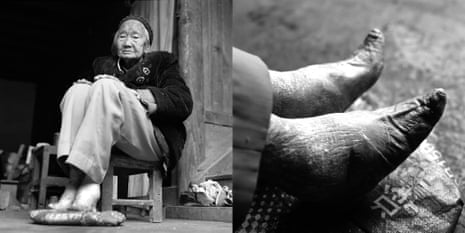Jo Farrell’s most recent photography project began, by chance, in the back of a cab. Her career-long interest is in documenting disappearing cultural practices, and in 2005 she got chatting to a Shanghai taxi driver about foot binding. “He mentioned that his grandmother had bound feet,” Farrell recalls. “Most people told me that it was such an old tradition, there were no women left. I went to the village of the cab driver’s grandmother, in the Shandong province, and met Zang Yun Ying. She became the first woman in my project.”
What followed was a nine-year journey across China, tracking down the last survivors of foot binding. She found just 50 women. Five of them were still completely bound and in hiding, but most had released their binds. All were from impoverished villages in the provinces of Yunnan and Shandong. The oldest, Zhang Yun Ying, was 103. Farrell’s photobook Living History: Bound Feet Women of China, contains close-up portraits of the severe deformity they suffered.
Foot binding was outlawed in China 103 years ago, following almost 10 decades of the practice. But the last factory producing “lotus shoes” – the triangular embroidered platforms used to showcase the women’s minuscule pointy feet – closed just six years ago.
To create the desirable “lotus feet”, first made fashionable under Emperor Li Yu in the 10th century, women would have their toes taped together tightly into triangular points. The feet were beaten, cast in herbs and oils to loosen the skin and strapped into lotus shoes.
After foot binding was banned it became taboo, and in 1950 Chairman Mao ordered anti foot-binding inspectors to publicly shame any bound women they found. “It was considered an old tradition that did not reflect modern China and should be stopped,” Farrell tells me from her flat in Hong Kong. “Their binding would be hung in windows so that people would laugh at them.”
Most women were bound at the age of seven. “The first year is particularly excruciating because the girls were made to walk until their toes would break under their weight,” says Farrell. “After that, the toes became numb and now, 50 or 60 years later, they don’t have any pain in their feet. It’s all quite numb.”
Farrell insists her photo series isn’t meant to sensationalise, but to educate us about a little-known custom. She admits she was surprised by her own reaction to seeing bound feet close up. “The first time I met Zang Yun Ying and held her foot in my hand it was just incredible – so soft and so incredibly formed.”
In spite of the brutality the project lays bare, its message is one of hope, survival and grit. “In Chinese society, it was the only way forward for women,” says Farrell. “They did it because they thought it would give them a better future, a better life.”

Comments (…)
Sign in or create your Guardian account to join the discussion